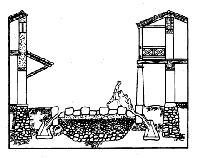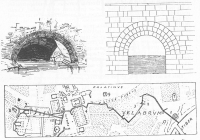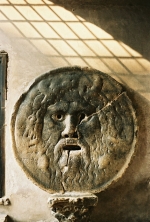


The sewers carried off sewage, urban runoff, and drainage water together (based on Macaulay).
WASTEWATER I: Rome
Wastewater outside RomeWater from the baths, latrines, palaces, fountains, etc., as well as other urban runoff was discharged into Rome's drainage and wastewater collection system. Several centuries before the birth of Christ, Etruscan engineers built the initial drainage system (Cloaca Maxima) whose main outlet into the Tiber River still exists 28 centuries later. The covered drains were designed on such a large scale that in certain sections wagons loaded with hay could drive through with ease. Rome's sewers and drains emptied directly into the Tiber, whose polluted state must have been a constant problem for the Roman populace.
 |
| Bocca della Verita in Rome, the famous 'mouth of the truth' in Rome near the church of Santa Maria in Cosmedin. There are many hypotheses about its image and purpose, see her 'official' website. |
The Roman sewers have been overpraised. Despite their longevity, they ignored basic sanitary principles. They carried sewage, urban runoff, and drainage water together. This multiple employment made it necessary to have large openings along the streets. These openings exposed Rome's populace to the effluvia of the sewers. To mitigate this danger to public health, Romans had only two protections: (1) the masses of water from infiltration and the aqueducts which constantly flushed the drains, and (2) the hilly nature of the city which gave the drains a steep slope.
The Roman sewer system probably carried off at least as much water as the aqueducts provided. Consumptive use in Rome was not high and there was a lot of infiltration into the drains from groundwater (parts of Rome are constructed over swamps). The flow of the Tiber River was greatly increased by discharges from Rome's sewers. Although the ancient sewers were very skillfully constructed, they were not used to their full potential. There were few private connections to the sewers. Even with the wastewater system's shortcoming, it is astonishing to note the absence of significant improvements in collection systems until the 1840's, some 17 centuries later.
Romans without indoor facilities were forced into one of two options. For a relatively small charge they could enter one of the city's public latrines or they could use chamberpots. (The Roman latrine system must represent one of history's earliest employments of the pay toilet, or more correctly, pay latrine, since the modern toilet was not invented until the sixteenth century.)
Rome's elaborate latrines were not a haven for the lazy, the misers, the poor, or the invalids. These latter groups had to resort to chamberpots. These were emptied into vats placed under the stairwells or, if vats were not provided, jars could be emptied into a nearby cesspool or an opening into the central sewer. There were many who found their stairs too steep, the distances to cesspools or sewers too far, and who found it more energy efficient to empty the contents of their chamberpots from windows onto the streets below. Emptying chamberpots in this fashion caused a great deal of irritation to passersby who happened to intercept an unwanted gift. Juvenal penned the following:
From every towering roof the rubbish falls,Fouled or even injured, the passer-by had no recourse except to file a complaint. Many passages written by Roman legal authorities indicate that the problem of falling debris was not trivial. Ulpian, a fourth century jurist, even classified the various clues by which it was possible for an injured party to find a culprit. If the guilty party was found, Ulpian recommended a penalty proportionate to the seriousness of the injury (as quoted in Carcopino, 1940, p. 43):
striking the head, and injuries grow rank.
See how pots strike and dint the sturdy pavement
There's death from every window where you move.
You'd be a fool to venture out to dine,
Oblivious of what goes on above,
Without you having penned the dotted line
Of your last testament,
You can but hope they spill a chamberpot.
When in consequence of the fall of one of these projectiles from a house, the body of a free man shall have suffered injury, the judge shall award to the victim in addition to medical fees and other expenses incurred in his treatment and necessary to his recovery, the total of the wages of which he has been or shall in the future be deprived by the inability to work which has ensued.It would appear that the lack of pumping in Rome may have inspired contemporary laws related to accidents and liability.
The instructions of Ulpian give us a glimpse of the conditions which must have existed in ancient Rome for such a legal analysis to be necessary. Clearly public sanitation must have been a very real problem. Many back streets must have reeked of urine and worse.
The Emperor Vespasian had the produce of the city's urinals collected, decanted and stored in cisterns, taxed, and sold to the guild of fullers (Suetonius, p. 319). (The fullers were the dry cleaners of Rome. They had discovered that the ammonia in urine had cleaning properties.) The Emperor's son Titus, a more gentee l individual, protested against the new tax. But pushing a coin beneath his son's nose, Vespasian reminded him, in one of his best know phrases, that "gold has no odor". When the emperor came to power, Rome was bankrupt; when he died it was not. Thus, it may well be that recycling human waste helped restore the Empire to economic well being. (The Emperor's illustrious name lives on in the vespasiennes, Parisian pissoirs in the graceful shape of sentry boxes.)
R.D. Hansen
From www.waterhistory.org
More about ancient sewer systems, see sewerhistory.org